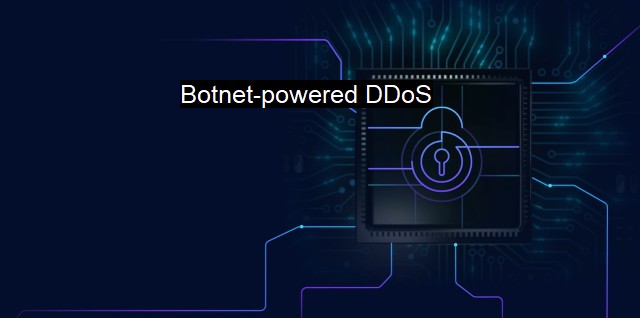What is Botnet-powered DDoS?
Botnets: A Severe Threat to Cybersecurity in the Digital Age with Persistent, Crippling DDoS Attacks Targeting Networks and Devices
A botnet-powered Distributed Denial of Service (DDoS) attack is a type of cyber threat with immense disruptive potential. To fully comprehend this cyber threat type, it's essential to factor in its constituent parts—namely, botnets and DDoS attacks.A botnet, in cybersecurity parlance, is a network of compromised, remotely controlled computers or bots that are often spread across several locations. The compromised computers are usually infected with malicious software, also known as malware, enabling remote control by cybercriminals. Botnets have become the launchpads of many nefarious cyber activities, including data theft, spamming, and importantly, DDoS attacks.
Each infected device within a botnet becomes a bot. These bots can receive commands from a central control server, known as a command-and-control (C&C) server, managed by the botmaster or botnet owners. Botnets are built either by infecting machines via deceptive links and downloads or via automated attacks exploiting security vulnerabilities in systems and software.
A DDoS attack, on the other hand, is a cyber-offensive in which an onslaught of data is directed towards a targeted website or online service. The main intention is to overwhelm the resource's network or server capacity, thereby causing it to slow down or entirely shut down, useless to legitimate users. DDoS attacks have drastically grown in frequency and scale, leading to significant business loss, reputational damage, and compromised user trust.
When put together, a botnet-powered DDoS attack forms the most potent form of the cyber offensive. Here, a botmaster uses the orchestration of botnets to inundate systems, networks, or services with resource-draining requests. The network flooded traffic chokes the targeted resource's capacity to handle simultaneous incoming data, crippling its operations and rendering it unavailable to legitimate users.
A considerable advantage for the perpetrators of these attacks comes from the dispersed nature of the botnet, which could stretch across nations and even continents. The vast geographic spread enhances the complexity and potency of the attack, making defending against it a significant challenge. Also, the anonymity offered by this method makes it difficult for law enforcement agencies to accurately locate the attack source and apprehend the culprits.
Botnet-powered DDoS attacks employ several methods, including volume-based attacks, protocol attacks, and application-layer attacks. Volume-based attacks aim to use up the victim's bandwidth, protocol attacks exploit vulnerabilities in the victim's resources, while application-layer attacks target the victim's applications.
Different forms of antivirus software and cybersecurity systems are deployed to monitor and counter botnet-powered DDoS attacks, employing numerous tactics like activity monitoring, maintaining updated threat intelligence, or establishing incident response plans. Specialized DDoS protection services use various methods and machine-learning algorithms to identify unnatural traffic and prevent their systems from getting swamped.
Protection against such intricate cyberattacks requires more than just deploying defensive algorithms. It involves fostering cyber threat awareness, exercising safe computing practices, regularly patching software, and securing networks. organizations need robust security frameworks and policies that can be quickly adapted and updated in line with evolving cyber threats.
Investing in cybersecurity and setting up DDoS protection systems are not just safety measures but a business necessity in today's digitally connected world. As technology strides forward, so does the sophistication and scale of attacks; the struggle between defense mechanisms and malicious activities continues. Understanding threats like botnet-powered DDoS attacks is crucial to sculpt-effective cybersecurity strategies and protect our businesses, digital infrastructures, and personal data from the relentless threats inherent in cyberspace.

Botnet-powered DDoS FAQs
What is a botnet-powered DDoS attack?
A botnet-powered DDoS attack is a type of cyberattack where a perpetrator uses a network of compromised computers, known as a botnet, to flood a target server or website with traffic. The goal of this attack is to overwhelm the targeted system, causing it to slow down or crash.How does a botnet work?
A botnet is a network of computers that are compromised by malware, allowing a remote attacker to control them. Once infected with this malware, the computer becomes part of the botnet and can be used to carry out various cyberattacks, including DDoS attacks. The attacker controls the botnet from a command and control (C&C) server, directing the bots to carry out their attack.How can I protect my system from a botnet-powered DDoS attack?
To protect your system from a botnet-powered DDoS attack, you should ensure that your antivirus software is up-to-date and that your software and firmware are regularly patched. You should also consider employing the use of DDoS mitigation services, which can help protect your system from an attack. It's also important to keep your network secure and monitor for any signs of botnet activity.What are some signs that my system is infected with botnet malware?
Some signs that your system may be infected with botnet malware include slow system performance, unfamiliar programs running in the background, and suspicious network activity. Additionally, if your system is involved in a DDoS attack, you may notice a significant increase in network traffic. If you suspect that your system is infected with botnet malware, you should immediately disconnect it from the internet and seek the assistance of a cybersecurity professional.| | A | | | B | | | C | | | D | | | E | | | F | | | G | | | H | | | I | | | J | | | K | | | L | | | M | |
| | N | | | O | | | P | | | Q | | | R | | | S | | | T | | | U | | | V | | | W | | | X | | | Y | | | Z | |
| | 1 | | | 2 | | | 3 | | | 4 | | | 7 | | | 8 | | |||||||